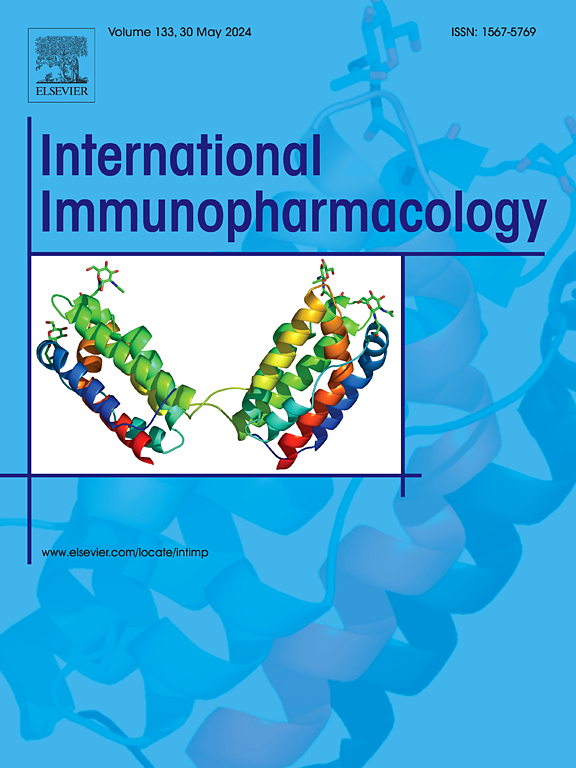Naltrexone reduces bleomycin-induced lung fibrosis in rats by attenuating fibrosis, inflammation, oxidative stress, and extracellular matrix remodeling
IF 4.7
2区 医学
Q2 IMMUNOLOGY
引用次数: 0
Abstract
Idiopathic pulmonary fibrosis (IPF) is a progressive and fatal lung disease characterized by excessive extracellular matrix (ECM) accumulation, fibroblast activation, and chronic inflammation. This study examined the antifibrotic effects of naltrexone (NTX), an opioid receptor antagonist, in a bleomycin (BLM)-induced pulmonary fibrosis model in Wistar rats. Daily administration of NTX significantly reduced alveolar wall thickening, collagen deposition, and histopathological injury scores. At higher doses, NTX markedly decreased levels of pro-inflammatory cytokines (TNF-α, IL-6, TGF-β), oxidative stress markers (MPO, NO), and key fibrotic markers including α-SMA and delta opioid receptor (DOR). Additionally, NTX restored antioxidant defenses (GSH, TAC) and enhanced GSK-3β phosphorylation, thereby modulating the Wnt/β-catenin and NF-κB signaling pathways. To further investigate the cellular mechanisms underlying NTX's antifibrotic activity, in vitro experiments were conducted using BLM-stimulated NIH-3 T3 fibroblasts. NTX inhibited the production of collagen type I and III, tissue inhibitors of metalloproteinases (TIMP-1 and TIMP-2), and matrix metalloproteinases (MMP-2 and MMP-9) in a dose- and time-dependent manner. This dual regulation of ECM synthesis and degradation suggests a more balanced therapeutic strategy compared to merely inhibiting collagen accumulation. Molecular docking analyses revealed strong interactions between NTX and key proteins involved in inflammatory and fibrotic signaling cascades. Notably, NTX at a dose of 20 mg/kg demonstrated antifibrotic efficacy comparable to that of pirfenidone. Collectively, these findings suggest that NTX exerts protective effects in pulmonary fibrosis by simultaneously targeting inflammation, oxidative stress, and ECM remodeling. Given its favorable tolerability and potential cost-effectiveness, NTX emerges as a promising candidate for IPF therapy. Further clinical investigations are warranted to evaluate its translational potential.
纳曲酮通过减轻纤维化、炎症、氧化应激和细胞外基质重塑来减轻博来霉素诱导的大鼠肺纤维化
特发性肺纤维化(IPF)是一种进行性和致死性肺部疾病,其特征是细胞外基质(ECM)过度积累、成纤维细胞活化和慢性炎症。本研究检测了阿片受体拮抗剂纳曲酮(NTX)在博来霉素(BLM)诱导的Wistar大鼠肺纤维化模型中的抗纤维化作用。每日服用NTX可显著降低肺泡壁增厚、胶原沉积和组织病理学损伤评分。在高剂量下,NTX显著降低促炎细胞因子(TNF-α, IL-6, TGF-β),氧化应激标志物(MPO, NO)和关键纤维化标志物(α-SMA和δ阿片受体(DOR))的水平。此外,NTX恢复抗氧化防御(GSH, TAC)和增强GSK-3β磷酸化,从而调节Wnt/β-catenin和NF-κB信号通路。为了进一步研究NTX抗纤维化活性的细胞机制,我们使用blm刺激的NIH-3 T3成纤维细胞进行了体外实验。NTX以剂量和时间依赖性的方式抑制I型和III型胶原、组织金属蛋白酶抑制剂(TIMP-1和TIMP-2)和基质金属蛋白酶(MMP-2和MMP-9)的产生。这种对ECM合成和降解的双重调节表明,与仅仅抑制胶原蛋白积累相比,这是一种更平衡的治疗策略。分子对接分析揭示了NTX与炎症和纤维化信号级联反应中涉及的关键蛋白之间的强相互作用。值得注意的是,剂量为20mg /kg的NTX显示出与吡非尼酮相当的抗纤维化功效。总的来说,这些发现表明NTX通过同时靶向炎症、氧化应激和ECM重塑在肺纤维化中发挥保护作用。鉴于其良好的耐受性和潜在的成本效益,NTX成为IPF治疗的有希望的候选药物。需要进一步的临床研究来评估其转化潜力。
本文章由计算机程序翻译,如有差异,请以英文原文为准。
求助全文
约1分钟内获得全文
求助全文
来源期刊
CiteScore
8.40
自引率
3.60%
发文量
935
审稿时长
53 days
期刊介绍:
International Immunopharmacology is the primary vehicle for the publication of original research papers pertinent to the overlapping areas of immunology, pharmacology, cytokine biology, immunotherapy, immunopathology and immunotoxicology. Review articles that encompass these subjects are also welcome.
The subject material appropriate for submission includes:
• Clinical studies employing immunotherapy of any type including the use of: bacterial and chemical agents; thymic hormones, interferon, lymphokines, etc., in transplantation and diseases such as cancer, immunodeficiency, chronic infection and allergic, inflammatory or autoimmune disorders.
• Studies on the mechanisms of action of these agents for specific parameters of immune competence as well as the overall clinical state.
• Pre-clinical animal studies and in vitro studies on mechanisms of action with immunopotentiators, immunomodulators, immunoadjuvants and other pharmacological agents active on cells participating in immune or allergic responses.
• Pharmacological compounds, microbial products and toxicological agents that affect the lymphoid system, and their mechanisms of action.
• Agents that activate genes or modify transcription and translation within the immune response.
• Substances activated, generated, or released through immunologic or related pathways that are pharmacologically active.
• Production, function and regulation of cytokines and their receptors.
• Classical pharmacological studies on the effects of chemokines and bioactive factors released during immunological reactions.

 求助内容:
求助内容: 应助结果提醒方式:
应助结果提醒方式:


